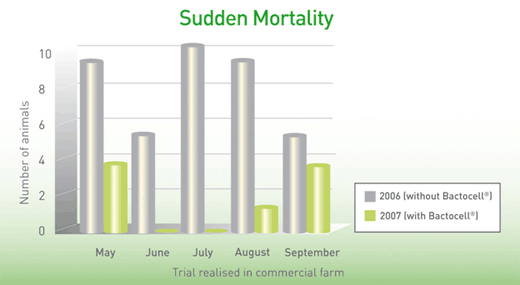death in fattening pigs during summer
Understanding and managing sudden death in fattening pigs during summer
High temperature often lead to digestive upset in pigs, and farmers often experience higher sudden death loss in fattening pigs, making preventive measures an economic necessity.
Sudden death, or HBS (hemorrhagic bowel syndrome)
Hemorrhagic bowel syndrome (HBS) causes the sudden death of 4-6 months-old fattening pigs (70-120 Kg). Usually, there is no clinical or pathological previous history, and no premonitory signs that could alert the farmer. In most of the cases, the weight and health conditions of the affected animals are perfectly normal. Due to the absence of premonitory signs, the diagnosis of HBS is mainly done post-mortem.
HBS can account for up to one-third of total fattening mortality. Out of 1.2 million pigs monitored in fattening, Straw (2002) has calculated 1.2% losses in total, of which 30.4% and 27.6% were linked to enterotoxemia during the first and second year, respectively.
Why is summer a high risk period?
When the temperature rises, both feed hygiene and animal behavior are affected. High temperature leads to the development of potential pathogenic microbes in liquid feed. It has been observed that heat stress affects pig feeding behavior, with changes in both feeding frequency and feed intakes, with pigs often only eating at night, resulting in either too rapid consumption or over-consumption. These tendencies are compounded by the animals' natural tendency to eat more but less often as they get older and heavier pigs are less capable to dissipate heat.
The changes in feed intake will in turn slow down, or even nearly halt to a once a day feeding. The large quantity of highly fermentable substrate in the digestive tract will thus favor excessive fermentations in the gastrointestinal tract, due to the development of endogenous or exogenous gas-producing bacteria.
Excessive gas production results in intestinal distension and compression, leading to a constriction of blood flow and lack of oxygen to gastrointestinal tissue. This phase is followed by the release of toxins by anaerobic bacteria. Abdominal pressure, linked to the mechanical activity caused by the gorging effect and the animal movements lead to the torsion of the digestive tract. This succession of events can finally cause the animal's sudden death.
Key success factors
While there is no treatment or effective solution to eradicate summer sudden deaths, some key success factors have been identified, which could help prevent the fatal culmination of effects.
- Feed safety and intestinal balance
Since hot weather favors microbial overgrowth, maintaining optimal hygiene within the farm is a key must to target. Indeed, high hygiene standards should be maintained at three levels: the feed, the feeding equipment, but also the animal gut microflora. Let's not forget that an adult pig is home to a mere 2 kg of microbes! - Feeding behavior
The objective is to maintain appetite and ensure regular feed intake.
The benefits of lactic acid bacteria
Numerous scientific studies and farm observations show that directing the feed fermentation by the addition of lactic acid bacteria (the homofermentative strain P. acidilactici MA 18/5M -or Bactocell- produces high levels of lactic acid and is authorized in EU as feed additive in fattening pigs), can help meet these key summer objectives.
- Feed safety
Because it does increase lactic acid concentration in the feed, Bactocell decreases the feed pH and ensures optimal hygiene in the feed and the equipment (formation of a positive biofilm over the surfaces). - Intestinal Balance
Because Bactocell also produces lactic acid in the gut, it will create an acidic environment that favors the development of Lactobacillus-type microflora, which will compete for nutrients with certain opportunistic bacteria such as salmonella, clostridia... - Feeding behavior
Bactocell improves the smell and palatability of liquid feed. This results in less feed refusal and more consistent feeding behaviors. Liquid feed remains fresh for longer periods allowing smaller, less developed pigs to consume quality feed. The homogenization among meals and animals will prevent overfeeding of certain animals, which could ignite the enterotoxaemia process. - Field efficacy
During summer 2007, a French commercial farm, which was usually affected by sudden death implemented the probiotic Bactocell in liquid feed. The following data speak for themselves.

References:
Straw B, Dewey C, Kober J, et al. "Factors associated with death due to hemorrhagic bowel syndrome in two large commercial swine farms". J Swine Health Prod. 2002;10(2):75-79.







